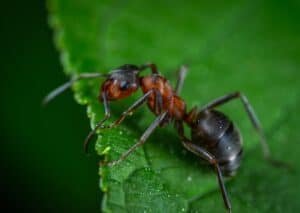Ants are a type of arthropod known as an insect. Arthropods are a phylum of invertebrate animals that includes insects, spiders, crabs, and lobsters. They are characterized by joint legs and a hard exoskeleton.
In this article we have discuss about How Many Ants Are Left In The World.
Table of Contents
The population of ants on earth – How Many Ants Are Left In The World ?

In terms of numbers, ants are some of the most successful animals on the planet. There is no one answer to this question as the population of ants varies greatly depending on the location.
It is estimated that there are between 10,000 and 20,000 different species of ants in the world and that they make up a significant proportion of the world’s insect population, which is estimated to be between 10 and 100 quintillions (1 followed by 18 zeroes).
Ants have lived on Earth since the beginning of the Cenozoic era, around 66 million years ago. So while there may be a lot of ants alive today, they are outnumbered by the trillions upon trillions of ants that have existed throughout history.
The population of ants with respect to biomass
Interestingly, the total biomass of ants is thought to be around the same as that of humans. This means that, although there are far fewer ants than people, they collectively weigh just as much. So next time you see an ant, remember that it is part of a vast and mighty population!
How many species of ants are there in the world?
While a precise answer to this question is not possible, because, there are many species of ants that have not yet been discovered and classified, it is estimated that there are between 10,000 and 20,000 different species of ants in the world, but we have only been able to identify and name about 12,500 of them.
So there are still a lot of ants that we know very little about. Ants are found in every continent except Antarctica, and they play an important role in many ecosystems. This means that ants make up a significant proportion of the world’s insect population.
While the exact number of ants in the world is impossible to determine, it is clear that they are a hugely successful and important part of the global ecosystem.
How do scientists manage to estimate the total number of ants on the planet?
To estimate the total number of ants on the planet, scientists first need to calculate the population density of ants in different ecosystems. This can be done by conducting population surveys in different areas and using mathematical models to extrapolate the data.
Once the population densities are known, scientists can then estimate the total number of ants by multiplying the population density by the total area of each ecosystem. For example, if the population density of ants in a rainforest is 10,000 colonies per square mile and the total area of the rainforest is 2 million square miles, then the estimated total number of ants in the rainforest would be 20 billion.
The final step is to add up the estimated total number of ants in all the different ecosystems to get a total. This total is believed to be around 10 quadrillions (10,000,000,000,000,000) of individual ants!
Succession of Arthropods
The high number of ants is due to their ability to adapt and survive in a wide range of environments. They are also able to reproduce quickly, with some species capable of producing up to 30,000 offspring in a single year. This ensures that their numbers continue to grow, even in the face of predation or other threats.
So, while we may not be able to give a definitive answer to how many ants are in the world, we can say that their numbers are vast and continue to increase. This makes them a species that is sure to have a lasting impact on our planet.
Most dominant creatures on earth
Respect for population density has shown that ants are some of the most dominant creatures on earth. Their populations have been recorded to be in the billions to trillions. Formica fusca, a species of ant, was once thought to be the most populous animal on Earth. However, recent studies have found that there are even more ants than previously thought.
Reasons for their succession
The sheer number of ants is mind-boggling. But how did they get to be so successful? One reason is their ability to adapt. Ants have been around for over 100 million years and have survived multiple mass extinctions. They are found in every continent except Antarctica and can live in a variety of climates.
Another reason for their success is their division of labor. ants have a complex social structure that includes different types of workers with specific tasks. For example, some ants are responsible for gathering food, while others build and repair the nest. This division of labor allows them to be more efficient and get more done.
The final reason for their success is their ability to cooperate. ants are able to cooperate in order to complete tasks that they couldn’t do alone. For example, when an ant colony needs to build a new nest, the workers will cooperate to carry the pieces of the nest and build it up.
Read Also: Do ants have brains? Here is what science says
How many ants are there in one ant colony?
The average ant colony has about 1 million members. However, there are species of ants that have colonies with up to 50 million members.
Which species of ants have the largest colony?
The Argentine ant has the largest colonies of any known ant species. These colonies can have up to 50 million members and span large areas. The queen ant of an Argentine ant colony can live for up to 15 years, and worker ants can live for up to 7 years.
What is the population density of ants?
The population density of ants varies depending on the species. Some species of ants live in very dense populations, while others have more sparse populations.
For example, the red fire ant has a population density of up to 1,000 ants per square meter. The Argentine ant, on the other hand, has a population density of only 10-20 ants per square meter.
Role In ecology
While ants may not be the most popular creatures, they play an important role in many ecosystems. They help to break down dead plant and animal matter, which helps to fertilize the soil.
They also prey on other insects, helping to control populations of pests. In some cases, they even provide food for larger animals such as birds, lizards, and pangolins
While ants may be small, they play a big role in much ecology around the world. The next time you see one; take a moment to appreciate these amazing creatures. They are important pollinators and help to disperse seeds. They also provide food for other animals, including humans. In some cultures, ants are even considered a delicacy!
Role as scavengers
As mentioned before, ants play an important role in decomposition. They help to break down dead plant and animal matter, which helps to fertilize the soil. This is important for plant growth and the health of the ecosystem as a whole.
In some cases, ants will even prey on other insects, helping to control populations of pests. This is especially beneficial to farmers, as it can help to protect crops from being destroyed by pests.
So, the next time you see an ant, don’t squish it – appreciate it for the important role it plays in our world.
Which country has the most number of ants?
The population density of ants varies widely depending on the ecosystem. For example, an acre of rainforest may contain up to 10,000 ant colonies, each containing up to 500,000 individual ants. This is much higher than the population density of ants in a desert ecosystem, which may only have a few hundred ant colonies per square mile.
So, when it comes to the question of which country has the most ants, it depends on the population density of ants in different ecosystems within that country. For example, a country like Brazil with a large rainforest area is likely to have more ants than a country like Canada with a smaller rainforest area.
Factors affecting the ant population
- The number of ants on Earth is affected by many factors, including weather, predators, and food availability.
- Ants are most active in warm weather, so their populations will be higher in warmer climates.
- Similarly, if there is an abundance of food (either from other insects or from human food sources), populations will be higher.
- Predators, such as birds, lizards, and other insects, can also have an impact on ant populations by reducing the number of ants that survive to maturity.
The optimum temperature for ants to live
- The optimum temperature for ants to live is between 30 and 35 degrees Celsius (86-95 degrees Fahrenheit).
- At these temperatures, ants are most active and their metabolism is at its peak.
- Ants will still survive in colder or hotter temperatures, but they will be less active and their populations will be lower.
Predators of ants
- Birds, lizards, pangolins, and other insects are the main predators of ants.
- These predators will eat both adult ants and ant larvae, which can impact the population of ants.
- In addition to natural predators, humans also play a role in ant populations by killing them with pesticides and other chemicals.
Conclusion
So, it is concluded that. There are an estimated 10,000,000,000,000,000 (ten quadrillions) ants alive on Earth at any given time. This means that for every human on the planet, there are approximately 1,600 ants.
The total weight of all the ants on Earth is estimated to be about the same as the total weight of all the humans on Earth, which is about 300 million tons.
Read Also: How Many Giant Pandas Are Left in the World





